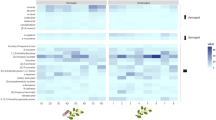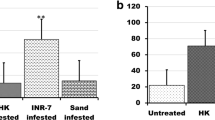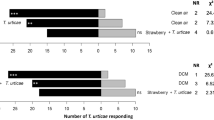Abstract
Recent work has shown the potential for enhanced efficacy of entomopathogenic nematodes (EPN) through their attraction to herbivore induced plant volatiles. However, there has been little investigation into the utilization of these attractants in systems other than in those in which they were identified. We compared (E)-β-caryophyllene and pregeijerene in the highbush blueberry (Vaccinium corymbosum) agroecosystem in their ability to enhance the attraction of EPN to and efficacy against the system’s herbivore, oriental beetle (Anomala orientalis). The relative attractiveness of (E)-β-caryophyllene and pregeijerene to a local isolate of the EPN species Steinernema glaseri was tested in a six-arm olfactometer in the laboratory to gather baseline values of attraction to the chemicals alone in sand substrate before field tests. A similar arrangement was used in a V. corymbosum field by placing six cages with assigned treatments and insect larvae with and without compound into the soil around the base of 10 plants. The cages were removed after 72 h, and insect baits were retrieved and assessed for EPN infection. The lab results indicate that in sand alone (E)-β-caryophyllene is significantly more attractive than pregeijerene to the local S. glaseri isolate Conversely, there was no difference in attractiveness in the field study, but rather, native S. glaseri were more attracted to cages with G. mellonella larvae, no larvae, and cages with the blank control and G. mellonella larvae.



Similar content being viewed by others
References
Ali JG, Alborn HT, Stelinski LL (2011) Constitutive and induced subterranean plant volatiles attract both entomopathogenic and plant parasitic nematodes. J Ecol 99:26–35
Ali JG, Alborn HT, Campos-Herrera R, Kaplan F, Duncan LW, Rodriguez-Saona C, Koppenhöfer AM, Stelinski LL (2012) Subterranean, herbivore-induced plant volatile increases biological control activity of multiple beneficial nematode species in distinct habitats. PLoS One 7:1–7
Anbesse S, Ehlers R-U (2013) Heterorhabditis sp. not attracted to synthetic ( E )-β-caryophyllene, a volatile emitted by roots upon feeding by corn rootworm. J Appl Entomol 137:88–96
Coleman DC, Crossley DA, Hendrix PF (2004) Fundamentals of soil ecology, 2nd edn. Elsevier Inc
Degenhardt J, Hiltpold I, Köllner TG, Frey M, Gierl A, Gershenzon J, Hibbard BE, Ellersieck MR, Turlings TC (2009) Restoring a maize root signal that attracts insect-killing nematodes to control a major pest. Proc Natl Acad Sci U S A 106:13213–13218
Duncan LW, Graham JH, Zellers J et al (2007) Food web responses to augmenting the entomopathogenic nematodes in bare and animal manure-mulched soil. J Nematol 39:176–189
Duncan L, El-Borai F, Cubero J, et al (2009) Differential susceptibility of entomopathogenic nematodes to nematophagous fungi from Florida citrus orchards. Nematology 11:231–241.
Gaugler R, Wang YI, Campbell JF (1994) Aggressive and evasive behaviors in Popillia japonica (Coleoptera: Scarabaeidae) larvae: defenses against entomopathogenic nematode attack. J Invertebr Pathol 64:193–199
Hiltpold I, Hibbard BE (2016) Neonate larvae of the specialist herbivore Diabrotica virgifera virgifera Do not exploit the defensive volatile (E)-β-caryophyllene in locating maize roots. J Pest Sci 89:853–858
Hiltpold I, Baroni M, Toepfer S, Kuhlmann U, Turlings TC (2010) Selective breeding of entomopathogenic nematodes for enhanced attraction to a root signal did not reduce their establishment or persistence after field release. Plant Signal Behav 5:1450–1452
Karban R, Baldwin IT (1997) Induced responses to herbivory. University of Chicago Press, Chicago
Koppenhöfer AM, Cmvipbell JF, Kaya HK, Gaugler R (1998) Estimation of entomopathogenic nematode population density in soil by correlation hetween hait insect mortality and nematode penetration. Fundam Appl Nematol 21:95–102
Li X-Y, Cowles RS, Cowles EA, Gaugler R, Cox-Foster DL (2007) Relationship between the successful infection by entomopathogenic nematodes and the host immune response. Int J Parasitol 37:365–374
Mauléon H, Briand S, Laumond C, Bonifassi E (1993) Utilization d’enzyme digestives pour l’etude du parasitisme des Steinernematidae et Heterohabditae enverse les larves d’insectes. Fundam Appl Nematol 16:185–186
McCoy C (2000) Entomopathogenic nematodes and other natural enemies as mortality factors for larvae of Diaprepes abbreviatus (Coleoptera: Curculionidae). Biol Control 19:182–190
Polavarapu S, Koppenhöfer AM, Barry JD, Holdcraft RJ, Fuzy EM (2007) Entomopathogenic nematodes and neonicotinoids for remedial control of oriental beetle, Anomala orientalis (Coleoptera: Scarabaeidae), in highbush blueberry. Crop Prot 26:1266–1271
Preisser EL, Dugaw CJ, Dennis B, Strong DR (2006) Plant facilitation of a belowground predator. Ecology 87:1116–1123
Price PW, Bouton CE, Gross P, McPheron BA, Thompson JN, Weis AE (1980) Interactions among three trophic levels: influence of plants on interactions between insect herbivores and natural enemies. Annu Rev Ecol Syst 11:41–65
Rasmann S, Turlings TC (2008) First insights into specificity of belowground tritrophic interactions. Oikos 117:362–369
Rasmann S, Köllner TG, Degenhardt J, Hiltpold I, Toepfer S, Kuhlmann U, Gershenzon J, Turlings TC (2005) Recruitment of entomopathogenic nematodes by insect-damaged maize roots. Nature 434:732–737
Rasmann S, Ali JG, Helder J, van der Putten WH (2012) Ecology and evolution of soil nematode chemotaxis. J Chem Ecol 38:615–628
Rivera MJ, Rodriguez-Saona C, Egizi A, Fonseca DM, Jennings DE, Koppenhöfer AM (2016) Cultivation and domestication of highbush blueberry (Vaccinium corymbosum) alters abundance, diversity and virulence of entomopathogenic nematodes. Agric Ecosyst Environ 222:148–155
Sokal RR, Rohlf FJ (1995) Biometry, 3rd edn. In: Freeman W.H and Company, New York
Stock SP, Goodrich-Blair H (2012) Nematode parasites, pathogens and associates of insects and invertebrates of economic importance. In: Lacey LA (ed) Manual of techniques in invertebrate pathology, 2nd edn. Elsevier, London, pp. 373–426
Underwood N, Rausher M (2002) Comparing the consequences of induced and constitutive plant resistance for herbivore population dynamics. Am Nat 160:20–30
Unsicker SB, Kunert G, Gershenzon J (2009) Protective perfumes: the role of vegetative volatiles in plant defense against herbivores. Curr Opin Plant Biol 12:479–485
van Tol RW, van der Sommen AT, Boff MI, Van Bezooijen J, Sabelis MW, Smits PH (2001) Plants protect their roots by alerting the enemies of grubs. Ecol Lett 4:292–294
Wardle DA (2002) Communities and ecosystems: linking the aboveground and belowground components. Princeton University Press, Princeton, NJ
Willett DS, Alborn HT, Duncan LW, Stelinski LL (2015) Social networks of educated nematodes. Sci Rep 5:14388
Acknowledgments
We thank Eugene Fuzy, John Sanders, and Rich Keller for technical assistance. We would also like to thank Kaitlyn Mathis for identifying Solenopsis molesta for us.
Author information
Authors and Affiliations
Corresponding author
Rights and permissions
About this article
Cite this article
Rivera, M.J., Rodriguez-Saona, C., Alborn, H.T. et al. Differential Response of a Local Population of Entomopathogenic Nematodes to Non-Native Herbivore Induced Plant Volatiles (HIPV) in the Laboratory and Field. J Chem Ecol 42, 1259–1264 (2016). https://doi.org/10.1007/s10886-016-0789-5
Received:
Revised:
Accepted:
Published:
Issue Date:
DOI: https://doi.org/10.1007/s10886-016-0789-5




